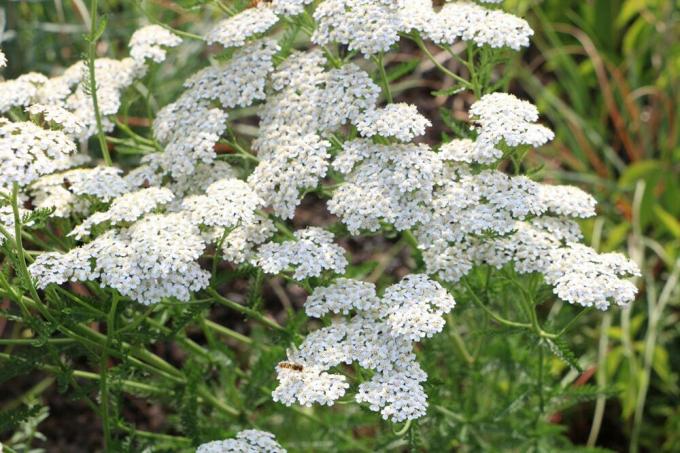

Table of contents
- Toxic or not?
- alkaloids
- trimethylamine
- What amount is toxic?
- Possible remedies
- When beechnuts are actually poisonous
For many people, finding, opening and eating beechnuts are part of a walk in the forest, just like the rustling of the leaves and the play of light and shadow. However, it is repeatedly pointed out that the seeds of the common beech are poisonous. For everyone who likes to enjoy the nutty aroma of beechnuts, the question now arises as to whether you should keep your hands off it in the future. In the following we explain how toxic the beechnut actually is and what should be considered when eating it.
Toxic or not?
The question of whether beechnuts are questionable must be answered with a clear "yes". Because, in fact, beechnuts contain, first and foremost, a high content of oxalic acid. Although this substance, which is also found in various other useful plants, is not critical at first, it can in the case of excessive intake or a disturbance of the oxalate balance in the human body quickly in the kidneys deposit. There it can lead to the following complaints:
- kidney gravel
- Kidney stones
- Other kidney diseases up to impaired kidney function
In addition, there are other substances in the raw beechnuts that lead to their official classification as slightly toxic:
alkaloids
The alkaloids include a variety of different substances, each of which can have its own effects. What they all have in common, however, is that they influence the human organism and can thus contribute to the symptoms of Fagin described below.
trimethylamine
This substance is derived from the Latin name of beech "Fagus" also referred to as Fagin. In doses that can occur with intensive consumption of beechnuts, the possible consequences are:
- irritation of the eyes
- Impairment of the respiratory organs in the form of coughing and irritation of the throat and pharynx
- nausea
- Vomit
What amount is toxic?

As always, the popular saying "The dose makes the poison" applies here. If individual beechnuts are eaten here and there during a walk in the forest, there are certainly no consequences to be feared. Even with children there is hardly any danger here. Only when beechnuts are specifically collected and consumed in large quantities should one consciously pay attention to possible symptoms and, if necessary, refrain from further consumption.
Possible remedies
The great advantage of the toxins contained in the beechnuts is that they are broken down by the effect of heat or converted into non-critical substances. This applies to oxalic acid as well as fagin and various alkaloids. Although you will rarely have the embarrassment of cooking beechnuts, roasting them can nut-like kernels can be a real alternative that eliminate toxins while enhancing the flavor intensify:
- Keep the roasting temperature low, as the oils contained from approx. 70 degrees Celsius burn and become bitter
- Plan the roasting time in such a way that all the seeds are continuously heated to at least 50 degrees Celsius, otherwise the toxins will not be broken down
- Due to the small size, constantly monitor the kernels during the roasting process to avoid burning them
- Due to the high oil content of the kernels, no separate addition of oil or fat is required
Info:
In the times of famine after the Second World War, it was common practice to collect beechnuts and brew them as a substitute for coffee. The roasting was used in a targeted manner in order to achieve the coffee-like aroma on the one hand, but also to eliminate the toxins at the same time.
When beechnuts are actually poisonous
A special case exists in which the beechnut actually appears to be more than slightly poisonous. Since the beechnuts fall from the tree when they are ripe and are therefore usually collected from the ground, the risk of mold infestation is relatively high. An obvious infestation is rather uncritical. It can be problematic if mold is already present but not yet clearly visible. If beechnuts are eaten in large numbers at this stage of infestation, older people and children in particular can suffer greatly from the toxins of the mold.
 Home editorial office
Home editorial office
Learn more about fall health

Grass mites / autumn grass mites bites in children - what to do?
Grass mites or autumn grass mites are inconspicuous, tiny animals - but their stings are still more than unpleasant and often found in children. The preventive and treatment measures that are useful for existing bites and extreme itching are revealed here.

Room bamboo: 13 tips for care
The room bamboo impresses with its compact growth habit and is a densely grown houseplant. The ten most important tips for caring for the sweet grass are compiled for you here.

Animals in the pool: what is it? | Larvae, maggots & Co
Worms in the pool are rightly unwanted guests in the cool water and usually indicate that something is wrong with the pool area.

10 good neighbors of raspberries | mixed culture
Raspberries should grow healthily for several years and bring us a rich harvest every time. Choosing a good neighborhood helps to achieve this goal. But with whom does the berry plant like to share the bed and with whom not?

Marsh snail in the pond | 9 Posture Tips
Of the nearly 100,000 species of snails, only about 40 live in freshwater. The mud snail is one of the ten species that can also be found in a pond. It inhabits the bottom of the body of water and contributes significantly to cleaning it there.

Yarrow in the lawn | How do I get rid of yarrow?
There is no question that yarrow is one of the best-known medicinal herbs. It helps against colds and is used for skin diseases and gynecological problems. On the manicured lawn, she is seen as a troublemaker. How do you get rid of them? Are there effective alternatives to the chemical club?


